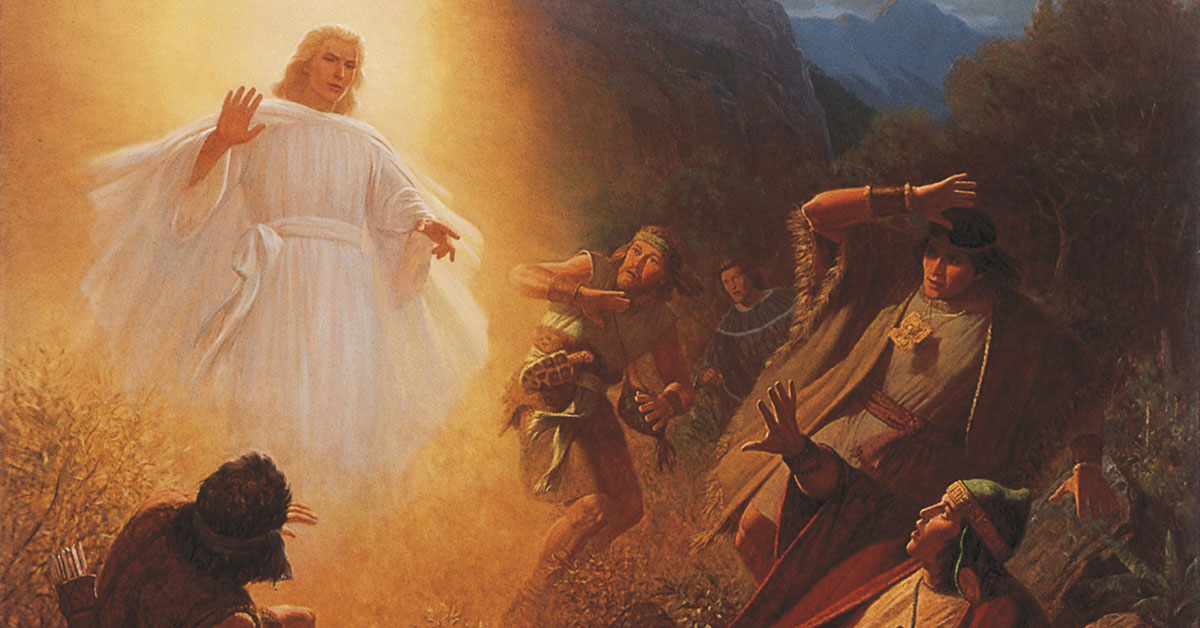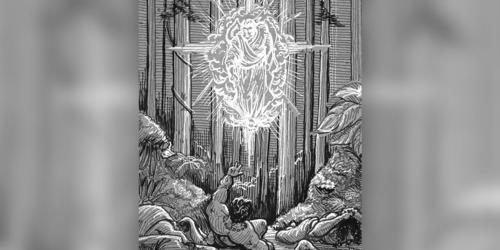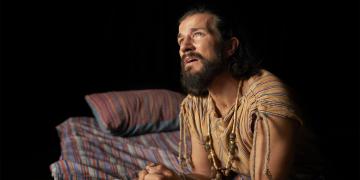You are here
Book of Mormon Central is in the process of migrating to our new Scripture Central website.
We ask for your patience during this transition. Over the coming weeks, all pages of bookofmormoncentral.org will be redirected to their corresponding page on scripturecentral.org, resulting in minimal disruption.
Come Follow Me 2020: Mosiah 25-28

Scripture Block
Mosiah 25–28
May 18–24. “They Were Called the People of God”
KnoWhys
Recommended Resources
Learn about the Book of Mormon with verse by verse commentaries from renowned Book of Mormon scholars like John W. Welch and Brant A. Gardner in the ScripturePlus app. Read this week's KnoWhy connected with the Come Follow Me curriculum, and watch a video elucidating an insight in this week's scripture reading.
Reading Plan
Structure your personal scripture study by following a multimedia, day by day plan. Each day's assignment includes the required scripture passages from the Come Follow Me curriculum, as well as suggestions for additional resources to bring context and understanding to your study. To dive deep, skip down to "Additional Resources" for a bibliography on Mosiah 25–28.
Monday
- Scripture: Mosiah 25:1–14
- KnoWhy 103: Has An Artifact That Relates to the Book of Mormon Been Found?
- Video: What Does the Book of Mormon Teach about Families? (1:29)
Explore Further
Tuesday
- Scripture: Mosiah 26:1–12
-
Quote: “An equally important part of fulfilling our parental duty to God is teaching our children the gospel and preparing them to participate fully in the Savior’s restored Church. Remember the lesson of King Benjamin’s people. As a result of his teachings, many of the adults had a mighty change of heart. But then it says that 'there were many of the rising generation that could not understand the words of King Benjamin, being little children at the time he spake unto his people; and they did not believe. … And their hearts were hardened.'”
Hales, Robert D. “Our Duty to God.” April General Conference 2010. -
Quote: “No charge in the kingdom is more important than to build faith in youth. Each child in each generation chooses faith or disbelief. Faith is not an inheritance; it is a choice. Those who believed King Benjamin learned that. Many of their children chose later not to believe. The scriptures give as a reason, ‘for they would not call upon the Lord their God’ (Mosiah 26:4)…teach doctrine and recount stories of faith and courage. I hope your students will remember the doctrine and the stirring stories. But most of all…how I pray it could be all-of your students will be more inclined to ‘inquire of the Lord,’ because of their experiences with you.”
Eyring, Henry B. “Helping Students Inquire of the Lord.” Address to Church Educational System religious educators, Feb. 2, 2001. - KnoWhy 104: How Was Mosiah a Type of Christ?
Wednesday
- Scripture: Mosiah 26:13–39
-
Quote: “Fearing to do wrong in the sight of God, Alma poured out his whole soul to God and pled with Him for answers as to how to handle the transgressors. Because of Alma's great love for his fellowman and his fervent desire to do God's will, the Lord blessed him mightily, even with a promise of eternal life. Then the Lord explained to him why his pleading for understanding in judgment was so important, saying: 'This is my Church. It is my name through which they will be saved. It is through my sacrifice. It is I who will judge.'”
Mickelsen, Lynn A. “The Atonement, Repentance, and Dirty Linen.” Ensign, November 2003, 10. -
Quote: “We want people in the Church not out of it, of course, but they must be in it on the Lord’s conditions. It is essential to maintain the integrity of the Church. Elder Dallin H. Oaks explained: ‘The objective of church discipline is to facilitate repentance,’ … He observed that ‘the principal purpose . . . [is] not to punish the transgressor, but to aid his repentance and save his soul.’ Moreover, ‘the most important single fact bearing on what church discipline is needed [is] the extent of repentance of the transgressor’ (Oaks, The Lord’s Way, 224–49).
“We are not interested in having people’s names ‘blotted out.’ We truly desire to see their sins blotted out.”
Ogden, D. Kelly, and Andrew C. Skinner. Verse by Verse: The Book of Mormon, 1:372. Salt Lake City, UT: Deseret Book, 2011.
Thursday
- Scripture: Mosiah 27:1–11
-
Quote: “Giving us weakness, however, is one of the Lord's ways of getting our attention. He says this is the means he uses to make us humble, but he also says that if we will come unto him and have faith in him, he will make us strong wherein we were weak. I know this is the truth. There are numerous examples in the scriptures that vividly illustrate this principle—Alma and the sons of Mosiah in the Book of Mormon, Peter and Paul in the Bible, to name just a few. Alma was going about tearing down the church until he met an angel who turned him around and made him one of the greatest missionaries we have any record of in the book of Mormon. Paul was out persecuting the saints when he met the Lord on the road to Damascus. After this experience, Paul became one of the greatest missionaries we have record of in the Bible. In his own words, he declared: ‘I can do all things through Christ which strengthened me.’”
Hartman Rector, Jr., “From Weakness to Strength.” General Conference April 1970. - KnoWhy 105: Why Did the Angel Speak to Alma With a Voice of Thunder?
Friday
- Scripture: Mosiah 27:12–22
-
Quote: “Mortal parents who make their own best efforts to reach their children can invoke divine assistance through prayer, for all scriptures unite in testifying that God answers prayers. Perhaps the Lord does send angels, but angels of a different sort. Inspired teachers, friends, bishops, home teachers, scout leaders, and others can serve the same function as angels from above. These embodied angels, inspired by the Holy Ghost, are sent by the Lord to assist and to love.”
Largey, Dennis L. “Lessons from the Zarahemla Churches.” Essay. In The Book of Mormon: Mosiah, Salvation Only through Christ, edited by Monte S. Nyman and Charles D. Tate, 68-69. Salt Lake City, UT: Greg Kofford Books, 1991. -
Quote: “Alma’s similarity to Saul/Paul is clear in the physical incapacity that resulted from the visitation (Acts 9:8). Contrary to Saul, however, Alma is completely debilitated. His companions are functional, able to carry him to assistance. Saul was only blind, but Alma was dumb and so weak that he was ‘carried helpless.’ That he was ‘laid’ before his father indicates that he was too weak even to sit. This physical weakness apparently resulted from a spiritual struggle, which he recounts later. Perhaps he was so preoccupied with the internal that his body was unable to cope with the external. Whatever the cause, his condition clearly stemmed from his experience with the angel.”
Gardner, Brant. Second Witness: Analytical and Contextual Commentary on the Book of Mormon, 4:454. Salt Lake City, UT: Greg Kofford Books, 2007.
Saturday
- Scripture: Mosiah 27:23–37
- Chart: Three Accounts of Alma's Conversion
- KnoWhy 501: What Does It Mean to Be “Born Again?”
Sunday
- Scripture: Mosiah 28:1–9
-
Quote: “‘All these things’ that the sons of Mosiah have been doing were attempts to rectify the effects of their preaching against the church in the land of Zarahemla. Because of their privileged position as the sons of the king, they had probably been instrumental in attracting many away from the church in Zarahemla. Therefore, they took their first mission to those whom they had most directly hurt.”
Gardner, Brant. Second Witness: Analytical and Contextual Commentary on the Book of Mormon, 3:461. Salt Lake City, UT: Greg Kofford Books, 2007. - Scripture: Mosiah 28:10–20
- KnoWhy 106: What Do the Jaredites Have to Do With the Reign of the Judges?
Explore Further
-
Quote: “Our own conversion must come first. The most important conversion for any of us is our own. If we are to bring the light of the gospel into others’ lives, it must shine brightly in our own. Once converted, the sons of Mosiah labored without ceasing to share the gospel with others, ‘for they could not bear that any human soul should perish.’ Only when we are converted to the Lord Jesus Christ are we in a position to strengthen others. And only then do we begin to understand that our lives truly do have meaning, purpose, and direction, and that as sisters united in our devotion to Jesus Christ our calling is to be a light to the world.”
Smoot, Mary Ellen W. “We are Instruments in the Hands of God.” General Conference October 2000. - KnoWhy 417: Were Joseph Smith’s Translation Instruments Like the Israelite Urim and Thummim?
Additional Resources
Mosiah 25
Largey, Dennis L. “Lessons from the Zarahemla Churches.” In The Book of Mormon: Mosiah, Salvation Only Through Christ, edited by Monte S. Nyman and Charles D. Tate, Jr., 59–71. Provo, UT: Religious Studies Center, Brigham Young University, 1991.
Welch, John W., and Greg Welch. “Benjamin's and Mosiah's Covenant Ceremonies Compared with Old Testament Rituals.” In Charting the Book of Mormon: Visual Aids for Personal Study and Teaching. Provo, UT: Foundation for Ancient Research and Mormon Studies, 1999, chart 101.
Mosiah 25:2
Book of Mormon Central. “Has An Artifact That Relates to the Book of Mormon Been Found? (Mosiah 25:2).” KnoWhy 103 (May 19, 2016).
Smith, Robert F., and Benjamin Urrutia. “New Information about Mulek, Son of the King.” In Reexploring the Book of Mormon, edited by John W. Welch, 142–144. Provo, UT/Salt Lake City: FARMS/Deseret Book, 1992.
Sorenson, John L. “The 'Mulekites.’” BYU Studies Quarterly 30, no. 3 (1990): 6–22.
Chadwick, Jeffrey R. “Has the Seal of Mulek Been Found?” Journal of Book of Mormon Studies 12, no. 2 (2003): 72–93, 117–118.
Skousen, Royal. “The Systematic Text of the Book of Mormon.” Journal of Book of Mormon Studies 11, no. 2 (2002): 45–66.
Wilson, Garth A. “The Mulekites.” Ensign, March 1987.
Wright, H. Curtis “Mulek,” in The Encyclopedia of Mormonism, 4 vols., ed. Daniel H. Ludlow (New York, N. Y.: Macmillan, 1992), 2:969–970.
Mosiah 25:6
Cazier, Donald A. “I Have a Question: We learn in Mosiah 25:6 that the account of Alma’s group covered the time they left Zarahemla until they “returned again.” Since Alma and his followers were presumably born in the land of Nephi and had never been to Zarahemla, how is this matter reconciled?” Ensign (August 1992).
Mosiah 25:8–11
Wright, David P. “Wade Brown, The God-Inspired Language of the Book of Mormon: Structuring and Commentary.” Review of Books on the Book of Mormon 1, no. 1 (1989): 10–17.
Mosiah 25:12
Book of Mormon Central. “What Does the Book of Mormon Teach about Families? (Mosiah 25:12).” KnoWhy 382 (November 16, 2017).
Roper, Matthew (2003). “Nephi’s Neighbors: Book of Mormon Peoples and Pre-Columbian Populations.” Review of Books on the Book of Mormon 15, no. 2 (2003): 91–128.
Sorenson, John L. “When Lehi’s Party Arrived in the Land, Did They Find Others There?” Journal of Book of Mormon Studies 1, no. 1 (1992): 1–34.
Mosiah 26
Largey, Dennis L. “Lessons from the Zarahemla Churches.” In The Book of Mormon: Mosiah, Salvation Only Through Christ, edited by Monte S. Nyman and Charles D. Tate, Jr., 59–71. Provo, UT: Religious Studies Center, Brigham Young University, 1991.
Thompson, A. Keith. “The Doctrine of Resurrection in the Book of Mormon.” Interpreter: A Journal of Mormon Scripture 16 (2015): 101–129.
Mosiah 26:12
Book of Mormon Central. “How Was Mosiah a Type of Christ? (Mosiah 26:12).” KnoWhy 104 (May 20, 2016).
Welch, John W. “What Was a ‘Mosiah’?” In Reexploring the Book of Mormon, edited by John W. Welch, 105–107. Provo, UT/Salt Lake City: FARMS/Deseret Book, 1992.
Mosiah 27
Largey, Dennis L. “Lessons from the Zarahemla Churches.” In The Book of Mormon: Mosiah, Salvation Only Through Christ, edited by Monte S. Nyman and Charles D. Tate, Jr., 59–71. Provo, UT: Religious Studies Center, Brigham Young University, 1991.
Tolley, Kevin L. “To ‘See and Hear.’” Interpreter: A Journal of Mormon Scripture 18 (2016): 139–158.
Van Dyke, Blair G. “Light or Dark, Freedom or Bondage: Enhancing Book of Mormon Themes through Contrasts.” Religious Educator: Perspectives on the Restored Gospel 6, no. 3 (2005): 99–116.
Welch, John W., and Greg Welch. “Three Accounts of Alma's Conversion.” In Charting the Book of Mormon: Visual Aids for Personal Study and Teaching. Provo, UT: Foundation for Ancient Research and Mormon Studies, 1999, chart 106.
Welch, John W., and Greg Welch. “Shared Words in the Three Accounts of Alma's Conversion.” In Charting the Book of Mormon: Visual Aids for Personal Study and Teaching. Provo, UT: Foundation for Ancient Research and Mormon Studies, 1999, chart 107.
Mosiah 27:8–10
Bowen, Matthew L. “’He Did Go About Secretly’: Additional Thoughts on the Literary Use of Alma’s Name.” Interpreter: A Journal of Mormon Scripture 27 (2017): 197–212.
Wirth, Diane E., and Steven L. Olsen. “Four Quarters.” In Reexploring the Book of Mormon, edited by John W. Welch, 145–159. Provo, UT/Salt Lake City: FARMS/Deseret Book, 1992.
Mosiah 27:11
Book of Mormon Central. “Why Did the Angel Speak to Alma With a Voice of Thunder? (Mosiah 27:11).” KnoWhy 105 (May 23, 2016).
Welch, John W., and Greg Welch. “People to Whom Jesus Christ or the Angel of the Lord Appeared.” In Charting the Book of Mormon: Visual Aids for Personal Study and Teaching. Provo, UT: Foundation for Ancient Research and Mormon Studies, 1999, chart 41.
Wright, Mark Alan. “Nephite Daykeepers: Ritual Specialists in Mesoamerica and the Book of Mormon.” In Ancient Temple Worship: Proceedings of the Expound Symposium, 14 May 2011, 243-257. Orem, UT/Salt Lake City: The Interpreter Foundation/Eborn Books, 2014.
Mosiah 27:16
Tvedtnes, John A. “The Captivity of the Fathers.” In The Most Correct Book: Insights from a Book of Mormon Scholar, 198–202. Salt Lake City: Cornerstone Publishing, 1999.
Mosiah 27:23
Welch, John W. “Three Accounts of Alma's Conversion.” In Reexploring the Book of Mormon, edited by John W. Welch, 150–153. Provo, UT/Salt Lake City: FARMS/Deseret Book, 1992.
S. Kent Brown. “Alma's Conversion: Reminiscences in His Sermons.” In A Book of Mormon Treasury: Gospel Insights from General Authorities and Religious Educators, 246–261. Provo, UT: Religious Studies Center, Brigham Young University, 2003.
S. Kent Brown. “Alma's Conversion: Reminiscences in His Sermons.” In From Jerusalem to Zarahemla: Literary and Historical Studies of the Book of Mormon, 113–127. Provo, UT: Religious Studies Center, Brigham Young University, 1998.
Mosiah 27:24–25
Reynolds, Noel B. “The Language of the Spirit in the Book of Mormon.” Interpreter: A Journal of Latter-day Saint Faith and Scholarship 33 (2019): 187–222.
Mosiah 27:25
Book of Mormon Central. “What Does It Mean to Be “Born Again?” (Mosiah 27:25).” KnoWhy 501 (February 7, 2019).
Christofferson, D. Todd “Born Again.” Ensign, May 2008, online at lds.org.
Perkins, Jerome M. “Alma the Younger: A Disciple’s Quest to Become.” In Living the Book of Mormon: Abiding by Its Precepts, edited by Gaye Strathearn and Charles Swift, 151–162. Provo, UT/Salt Lake City: Religious Studies Center, Brigham Young University/Deseret Book, 2007.
Top, Brent L. “Spiritual Rebirth: Have Ye Been Born of God?” In The Book of Mormon and the Message of The Four Gospels, edited by Ray L. Huntington and Terry B. Ball, 201-217. Provo, UT: Religious Studies Center, 2001.
Wilcox, S. Michael. “Spiritual Rebirth.” In The Book of Mormon: Mosiah, Salvation Only Through Christ, edited by Monte S. Nyman and Charles D. Tate, Jr., 247–260. Provo, UT: Religious Studies Center, Brigham Young University, 1991.
Mosiah 27:28–29
Spackman, T. Benjamin. “The Israelite Roots of Atonement Terminology.” BYU Studies Quarterly 55, no. 1 (2016): 39–64.
Mosiah 27:34
(Himni) Tvedtnes, John A., John Gee, and Matthew Roper. "Book of Mormon Names Attested in Ancient Hebrew Inscriptions." Journal of Book of Mormon Studies 9, no. 1 (2000): 40-51, 78-79.
Larsen, Val. “In His Footsteps: Ammon 1 and Ammon 2.” Interpreter: A Journal of Mormon Scripture 3 (2013): 85–113.
Mosiah 28
Halverson, Taylor. “Deuteronomy 17:14–20 as Criteria for Book of Mormon Kingship.” Interpreter: A Journal of Mormon Scripture 24 (2017): 1–10.
Mosiah 28:3–8
Williams, Clyde J. “Instruments in the Hands of God: The Message of Alma 17-27.” In The Book of Mormon: Alma, The Testimony of the Word, edited by Monte S. Nyman and Charles D. Tate, Jr., 89–105. Provo, UT: Religious Studies Center, Brigham Young University, 1992.
Mosiah 28:11
Reeve, Jr., Rex C. “The Book of Mormon Plates.” In The Book of Mormon: First Nephi, The Doctrinal Foundation, edited by Monte S. Nyman and Charles D. Tate, Jr., 99–111. Provo, UT: Religious Studies Center, Brigham Young University, 1988.
Mosiah 28:13
Hoskisson, Paul Y. “Urim and Thummim.” In Encyclopedia of Mormonism, Edited by Daniel H. Ludlow.
Spencer, Stan. “What Did the Interpreters (Urim and Thummim) Look Like?” Interpreter: A Journal of Latter-day Saint Faith and Scholarship 33 (2019): 223–256.
Spencer, Stan. “Seers and Stones: The Translation of the Book of Mormon as Divine Visions of an Old-Time Seer.” Interpreter: A Journal of Mormon Scripture 24 (2017): 27–98.
Mosiah 28:14
Smith, Miriam A., and John W. Welch. “Joseph Smith: ‘Author and Proprietor.’” In Reexploring the Book of Mormon, edited by John W. Welch, 154–157. Provo, UT/Salt Lake City: FARMS/Deseret Book, 1992.
Mosiah 28:17
Book of Mormon Central. “What Do the Jaredites Have to Do With the Reign of the Judges? (Mosiah 28:17).” KnoWhy 106 (May 24, 2016).
John A. Tvedtnes, “King Mosiah and the Judgeship,” Insights: A Window on the Ancient World 20, no. 11 (2000): 2; reprinted in Insights: A Window on the Ancient World 23, no. 1 (2003): 2.




